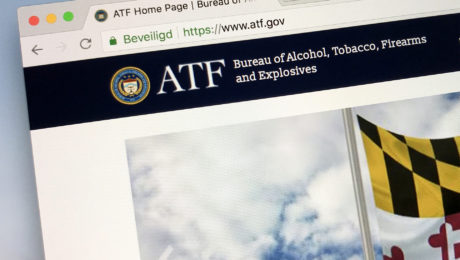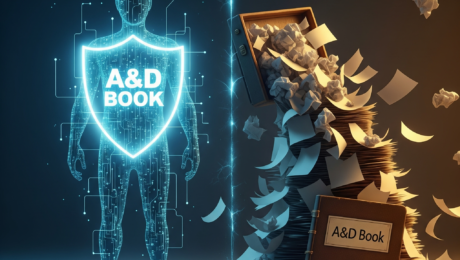The A&D Bound Book: Essential Requirements for FFL Compliance
Wednesday, August 20 2025
In the highly regulated firearms industry, it’s mandatory to adhere to the regulations set by the Bureau of Alcohol, Tobacco, Firearms, and Explosives (ATF), especially when it comes to the bound book requirements for firearms businesses. A bound book is a record-keeping tool that tracks the acquisition and disposition of firearms, ensuring that dealers operate within the law. This comprehensive record is the foundation of every Federal Firearms Licensee’s (FFL) compliance strategy. It is not just a regulatory necessity—it’s a critical tool for business management and the key to a successful ATF audit. What to Record: Acquisition Requirements Every time your FFL acquires a firearm, you must create a detailed and permanent record in your bound book. This entry is a foundational log of the firearm’s entry into your inventory and is a non-negotiable step for compliance. The ATF requires the following information for each acquisition: Date of Acquisition: The exact date the firearm was received by your licensed premises. This serves as the official start of the firearm’s life in your inventory. Source Information: The full name and address of the individual or company from which the firearm was acquired. This is essential for maintaining a clear chain of custody. Firearm Details: Comprehensive information including the firearm’s serial number, manufacturer, model, type (e.g., handgun, rifle, or shotgun), and caliber or gauge. The serial number, in particular, is vital for all tracking and identification purposes. What to Record: Disposition Requirements When a firearm is sold or transferred, a corresponding disposition record must be made. This entry closes the loop on the firearm’s journey through your inventory and must be linked to the final transaction. The required details for each disposition include: Date of Disposition: The precise date the firearm was transferred to its new owner. Transferee Information: The full name, address, and driver’s license number of the person receiving the firearm. Accurate customer information is paramount for legal transactions. Firearm Details: The same comprehensive details as the acquisition record (serial number, manufacturer, model, etc.) to ensure a direct match. ATF Form 4473 Number: This number is a critical detail as it links the disposition to the background check and official firearms transaction record, providing an auditable trail for the ATF. Format, Organization, and Technology While the original Gun Control Act of 1968 referred to a physical “bound book,” the ATF now permits electronic record-keeping, a transformative change for the industry. Whether you use paper or digital records, certain rules apply: entries must be legible, permanent, and kept in chronological order. FFLs must retain these records for at least 20 years, a minimum requirement that highlights the importance of durability and security. This is where modern technology becomes a game-changer. An electronic bound book, like the ones integrated into Bravo Store Systems and E4473, automates many of these requirements. Digital systems provide immediate error checking, secure off-site backups, and seamless integration with your Form 4473 process, ensuring that every record is accurate and properly stored for decades to come. Navigating ATF Audits An ATF inspection is a crucial part of an FFL’s business, conducted by an Industry Operations Investigator (IOI) to ensure compliance. During an audit, your A&D book will be the primary record reviewed. Having an accurate and well-organized record makes this process quick and stress-free. With a digital system, you can pull up records instantly, demonstrate compliance, and focus on running your business rather than sifting through endless paper files. The consequences for non-compliance can be severe, ranging from hefty fines to the revocation of your FFL license. Ultimately, proactive compliance is key. By meticulously following these A&D bound book requirements and leveraging the right technology from solutions like Bravo Store Systems and E4473, FFLs can ensure they are fully compliant, legally protected, and operating with maximum efficiency.
- Published in Form 4473, Gun Stores, Uncategorized
No Comments
ATF Audit-Proofing Your Business: The Unseen Power of E4473 Compliance Automation
Wednesday, August 13 2025
For Federal Firearms Licensees (FFLs), staying on top of the ever-evolving landscape of ATF regulations is not just a best practice—it’s a critical requirement for a successful and legally sound business. One of the most common challenges FFLs face is ensuring every single Form 4473 is filled out perfectly. A single, small error can lead to a violation, fines, or even the loss of your license. This is where the transformative power of E4473 Compliance Automation comes in, offering a strategic solution that is rapidly becoming the industry standard. What is Compliance Automation in E4473? At its core, compliance automation within an E4473 software solution is a sophisticated system of checks and balances designed to guarantee accuracy. It’s more than just a digital version of a paper form; it’s an intelligent platform that acts as your dedicated compliance officer on every single transaction. Real-time Validation: These solutions are engineered with every single ATF regulation built into their framework. As a customer fills out the form, the system performs real-time validation, flagging missing fields, incorrect information, or answers that may require further follow-up. This proactive approach eliminates a significant number of common errors before they are ever finalized. Automatic Updates: One of the most powerful features is the ability to automatically update when the ATF revises the Form 4473. With recent legislative changes, such as those from the Bipartisan Safer Communities Act, forms are subject to revision. A robust E4473 platform automatically pushes these updates, ensuring you are always using the most current, legally compliant form without any manual effort or risk of using an outdated version. Why This Automation is Your Best Defense Peace of Mind: Knowing that every transaction is being meticulously checked by a system designed to enforce compliance and minimize errors provides unparalleled peace of mind. You can focus on serving your customers and growing your business, rather than constantly worrying about record-keeping integrity. Time and Cost Savings: Manual record-keeping is not only prone to error but is also a significant time sink. Compliance automation eliminates countless hours spent on double-checking forms, correcting mistakes, and physically organizing paperwork, freeing up your team to be more productive. Audit-Proofing Your FFL: The primary goal of every FFL is a clean ATF audit. The overwhelming majority of violations found during an inspection are related to mistakes on Form 4473. By automating compliance, you are building an audit-proof system that ensures your records are accurate, complete, and easily accessible—a true game-changer for your business’s security. In an industry where the stakes are high, relying on a system that automates and guarantees your compliance isn’t just a convenience—it’s a necessity. Don’t leave your business’s future to chance. Ready to see how E4473 compliance automation can protect your business and streamline your operations? Contact us today to learn more!
- Published in ATF, Bulletproof Security, Business Portal, Form 4473, Gun Stores, Uncategorized
The A&D Book: Your Digital Guardian or Paper Pitfall?
Tuesday, August 05 2025
For every Federal Firearms Licensee (FFL), the Acquisition & Disposition (A&D) book isn’t just a record; it’s the heartbeat of your compliance. This “bound book” is the chronological log of every firearm that enters and leaves your inventory. Historically, it was a literal paper book. Today, however, managing this critical record on paper can be a time-consuming, error-prone endeavor – a potential pitfall in the eyes of the ATF. We understand the unique challenges FFLs face and champion robust solutions designed for precision and peace of mind in compliance. Why Your A&D Book is Non-Negotiable The A&D book serves several vital purposes: Traceability: It allows the ATF to trace the ownership of firearms from manufacturer to consumer, crucial for law enforcement investigations. Accountability: It provides a clear record of every firearm in your possession, demonstrating your adherence to responsible business practices. Compliance: Accurate and timely entries are a fundamental requirement of your FFL. Errors or omissions can lead to severe penalties, including fines, suspension, or even revocation of your license. Best Practices for Maintaining Impeccable A&D Records Whether you’re currently using paper or considering a digital transition, these best practices are essential: Timely Recording: Acquisitions: Every firearm received must be entered into your A&D book immediately upon receipt. This includes purchases, consignments, gunsmithing repairs, and returns. Dispositions: Every firearm disposed of (sold, transferred, destroyed, returned to owner) must be recorded immediately upon disposition. The key is “contemporaneously” – as it happens, not at the end of the day or week. Complete and Accurate Entries: Acquisition Information: Date of acquisition, name and address of the transferor (or FFL name and license number), manufacturer, importer (if any), model, serial number, type, caliber/gauge. Disposition Information: Date of disposition, name and address of the transferee (or FFL name and license number), and the ATF Form 4473 serial number (for non-licensee transfers). No Erasures or White-Out: For paper books, corrections must be made by drawing a single line through the error, writing the correct information, and initialing/dating the change. Digital systems handle corrections with audit logs, maintaining a clear history. Managing Repairs and Consignments: Firearms taken in for repair or on consignment must be properly acquired into your A&D book. When the repaired firearm is returned to its original owner, it must be properly disposed of, often linked to the initial acquisition entry. Consigned firearms that are sold through your FFL follow the standard disposition process. Reconciliation with Physical Inventory: Regularly reconcile your A&D book with your physical inventory. This involves comparing what your book says you have to what you physically possess. Discrepancies must be investigated immediately. Unaccounted for firearms may need to be reported as lost or stolen. Reporting Lost/Stolen Firearms Within 48 Hours: This is a critical, federally mandated requirement. If a firearm is lost or stolen from your inventory, you must report it to both your local law enforcement agency and the ATF within 48 hours of discovery. A corresponding entry must be made in your A&D book, noting “stolen” or “missing,” the date of discovery, and the ATF incident number. Embrace Your Digital Guardian While paper A&D books are still permissible, the advantages of electronic solutions are undeniable. They offer automated accuracy, real-time visibility, effortless reconciliation, audit-ready reports, and secure, compliant storage. They create a streamlined workflow that saves time and minimizes stress. Don’t let your A&D book be a paper pitfall. Embrace the future of FFL compliance. Bravo Store Systems provides comprehensive inventory management and integrated A&D tracking, while E4473 empowers you with a digital solution for ATF Form 4473. Together, these systems can serve as your reliable digital guardians, helping you stay compliant and allowing you to focus on what you do best: serving your customers and growing your business.
- Published in ATF, Bravo Store Systems, Bulletproof Security, Business Portal, Cloud Storage, Form 4473
- 1
- 2



